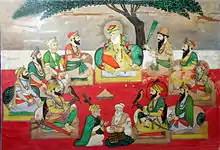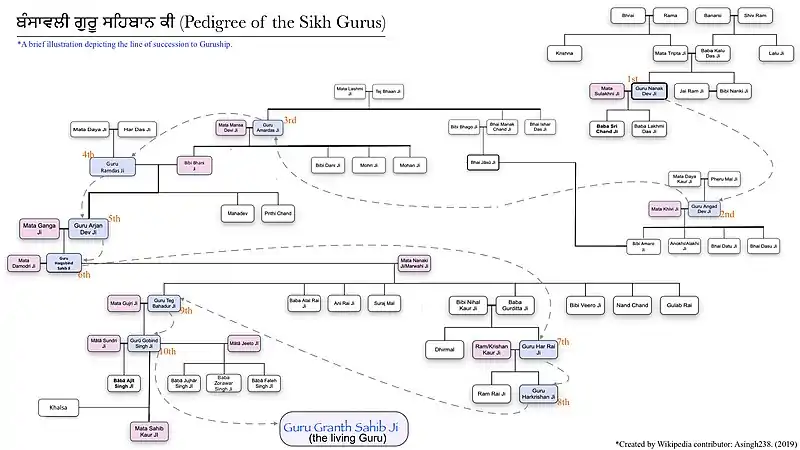Sikh gurus
The Sikh Gurus (Punjabi: ਸਿੱਖ ਗੁਰੂ) are the spiritual masters of Sikhi, who established this religion over the course of about two and a half centuries, beginning in 1469.[2] The year 1469 marks the birth of Guru Nanak, the founder of Sikhism. He was succeeded by nine other gurus until, in 1708, the Guruship was finally passed on by the tenth guru to the holy Sikh scripture, Guru Granth Sahib, which is now considered the living Guru by the followers of the Sikh faith.[3]

Etymology and definition
Guru (/ˈɡuːruː/, UK also /ˈɡʊruː, ˈɡʊər-/; Sanskrit: गुरु, Punjabi: ਗੁਰੂ, IAST: guru) is a Sanskrit term for a "teacher, guide, expert, or master" of certain knowledge or field.[4] Bhai Vir Singh, in his dictionary of Guru Granth Sahib describes the term Guru as a combination of two separate units: "Gu;(ਗੁ)" meaning darkness and "Rū;(ਰੂ)" which means light.[5] Hence, Guru is who brings light into darkness or in other words, the one who enlightens.
Bhai Vir Singh's definition provides further insight about Sikhi itself and explains why Guru Granth Sahib is considered the living Guru. The word Sikh is derived from the Sanskrit term shishya[6](Punjabi: ਸਿੱਖ) which means a disciple or a student. Thus, Sikhs have a student-teacher relationship with their Gurus since their teachings, written in Guru Granth Sahib, serve as a guide for the sikhs.
The Gurus
Timeline of Sikh Gurus

Pedigree of Sikh Gurus[note 2]

See also
References
- The Sikhs. E.J. Brill. p. 38. ISBN 9004095543.
- Sen, Sailendra (2013). A Textbook of Medieval Indian History. Primus Books. pp. 186–187. ISBN 978-9-38060-734-4.
- The Sikhs : faith, philosophy & folk. Lustre Press. ISBN 9788174360373.
- Stefan Pertz (2013), The Guru in Me - Critical Perspectives on Management, GRIN Verlag, ISBN 978-3638749251, pages 2-3
- Singh, Veer (1964). Sri Guru Granth Kosh. p. 122.
- World religions : from ancient history to the present. ISBN 978-0-87196-129-7.
Notes
- officially observed on Kartik Puranmashi (October–November)
- Listed names and relations might vary from source to source since different aspects of Sikh history have been written by many different individuals over the course of past six centuries.









